August 25, 2010
Turning — revisited
I’m in the process of applying for a grant, which is something that I haven’t done for several years. Grants are, as they say, a crapshoot, and it’s true. I applied for ASCAP Young Composer grants every year from the time I was 18, and I didn’t receive one until I was 29 — in my last year of eligibility. So, eleven tries, and plenty of much-better composers never received one.
I was trying to decide what works to submit with this grant application, and that’s a tough decision — not because I have so many great pieces, but really because you never have any idea what that particular grant panel is looking for. Do they like what I call “bleepy-bloopy” music — the kind of disjointed atonal music that, whenever I happen to hear it at a new music concert, I think to myself, “really? People still write this stuff?” Are they more into the “Bang on a Can”-type stuff (which is really more my own aesthetic, too)? In other words, do the panelists want music that’s harmonically challenging (like, say, “Turning“), or rhythmically driving (like “Asphalt Cocktail“)? There’s no way to know, because the panel is anonymous.
I’m submitting three works. Two of them are large-structure works — my Soprano Sax Concerto and “Harvest: Concerto for Trombone” — because I’m trying to get funding for a new large-structure work, and I want to show that I can write a big piece. But what’s the third piece? Since the panel will be composers, and that’s a very different panel to try to impress than a panel of performers or conductors, I think I need to send something a little crunchier. I’m sending “Turning.”
I wrote “Turning” back in the summer of 2006 on commission from an old high school friend who is now a high school band director in Chicago. My thinking was “slow music = easy music.” Ha! Oops. Not only is “Turning” most definitely not a “high school” piece, it’s a piece that college groups find more than sufficiently challenging. I mean, the bass trombone plays a rip up to high B in the second bar! The bass trombone! NO! DON’T EVER WRITE LIKE THAT!
The original ideas for “Turning” came from two sources: 1) a new sample library I purchased that contained an instrument called a “Waterphone,” and 2) the beautiful brass chorale by Bjork that opens the film “Dancer in the Dark.” Waterphone = creepy. Bjork (really, any Bjork) = beautiful, haunting, and… well, creepy. So my first thought was, why not combine waterphone and Bjork, resulting in music that sounds almost like the score for a horror film?
Admittedly, for whatever reason, “Turning” doesn’t get many performances at all. I don’t know if it’s because it requires a waterphone, but that probably doesn’t help. I purchased a genuine waterphone from its inventor, Richard Waters, and I rent it to schools that want to perform the piece, but that doesn’t really seem to make much difference. (There are “knock-off” waterphones, but they really don’t sound the same, and the real instrument sells for over $1000, so almost no schools own them — an exception being the University of Kentucky, with Jim Campbell and his phenomenal percussion studio.)
I think it has hurt the piece that there hasn’t been a great recording on this site. That isn’t the fault of the performances or the performers, but more the fault of the ridiculous dynamic range of the work, which ranges from FFFF in bar 1 to pppp in the final bar, and back and forth throughout. (One thing “Turning” is: dramatic.) The quietest moments use a lot of bottom-register bass clarinet and contrabass clarinet, and those instruments, at extremely quiet dynamics, often aren’t picked up by stage microphones, as they end up quieter than the hall ventilation system. This means that without some meticulous mastering, many quiet chords in previous recordings were lacking the root of the chord.
Well, no more. Because I needed to submit “Turning” for this grant application, I spent 8 hours yesterday (yes, 8 hours) tweaking the recording. Richard Clary at Florida State University had given a wonderful performance of the piece back in 2007, and he had given me recordings from several of his rehearsals plus his performance, with the microphones in the same location for each recording. This allowed for editing between takes and doubling of parts. I spliced, diced, EQ’d, tweaked reverb, messed with compression — just about every trick I know — and I now finally have what I think is a damn-near perfect recording of “Turning.”
If you’ve ever listened to “Turning” before, I hope you’ll give it another listen. This recording sounds nothing like any previous version. When I sent him the final mix last night, Rick Clary said, “This might be the most beautifully terrifying thing I have ever heard.”
August 4, 2010
Hymn to a Blue Hour – demo
I thought I had finished “Hymn to a Blue Hour” last week. I posted the blog entry about the piece and sent the initial MIDI demo to several people. There were a few tiny things that still bugged me about the piece, though. The “notes” were right, but there was one note in particular that just seemed risky: written high-D (above the staff) for the trumpets. The piece was also barred in very slow rhythms — 4/2, 5/2, etc., with a few bars in 9/4 — and I thought that might be a lot to ask. Sure, it looked like the score for Samuel Barber’s Adagio for Strings, but was that style of notation going to be more problematic than it was worth?
My first thought was, Why not have two versions? There would be the original version with the long meters and high D in the trumpet (and high C in the euphonium in the same measure!), and an alternate version with a modulation removed (taking the whole last third of the piece down a whole step, meaning that every presentation of the theme would be in the same key) and all of the rhythms cut in half, so 4/2 would become 4/4, 3/2 would become 3/4, 9/4 would become 9/8, etc. I posted this plan on Facebook:
John Mackey is considering offering two versions of the new piece, “Hymn to a Blue Hour” — the “difficult” version, plus a slightly simplified “medium” version with a modulation removed (to keep the parts from entering the stratosphere as they do now) and time signatures simplified (2/2 becomes 2/4, etc.). Thoughts?
This generated more responses than I’ve ever had on Facebook — more than 75 comments. Some of the conversation follows:
Daniel Haysuskristo Snell nooo keep it hardcore-only.
Chris David Westover Nope! Offer what you envisioned. I’m excited to see the score and hear this new work. The last thing we need is simplified stuff. We need inspired works, so give us that version!
John Mackey Daniel & Chris — I’m talking about offering two versions. I imagine most people would order the “original,” but it makes sense to offer a slightly more-playable version that’s still the same piece.
Zac Brunell I don’t think it’s necessary to do anything like that. An ensemble should have to work to play good music. Not to say that all bad music is easy, just that I think the slightly less attainable material is that much more interesting in terms of the composer’s intentions.
Daniel Haysuskristo Snell or perhaps a version of it thats even harder? like mario galaxy 2 or something =P
Don Nathan Excellent idea as long as the music isn’t compromised. More John Mackey that is accessible to high school bands is a great thing! Do you think changing 2/2 to 4/4 is really necessary? Do you think it will effect the “feel” of the piece? I find many conductors of young bands will make that switch whether it’s marked or not, and I think it is sometimes a bad idea because it effects the flow of the music… too many pulses. It’s not that difficult for kids to learn to play in 2/2.
John Mackey Okay, Daniel — that’s actually pretty funny. It’d be like levels on games. “Easy,” “Normal,” “Hardcore.”
Jeremy Howard Beck John: why not just provide an ossia for that trumpet part? Seems like massively less work than creating a whole different version. And I second what lots of others have already said: once you start thinking in terms of an “easy” version and a “hard/original” version, you (unconsciously) start thinking of every musical decision in terms of that paradigm, rather than in terms of how it serves your vision. Write the piece you want to write and let players rise to the challenge of it.
Travis Taylor I think you should offer a retrograde version too, just for kicks and laughs. And it has to be played in succession of the original work.
Don Nathan A good conductor/teacher will have kids playing 5/2 without a lot of heartburn. In my experience, it’s really not a difficult concept to beat the half note. There are many lower level band pieces that use a variety of mixed meters including duple to triple switches and simple to compound switches. I say go with how the music should feel. That’s the most important consideration.
Drew Schweppe No, keep it the way you would want to hear it. Those kids will have to learn about the time signatures at some point why not now?
Alexander Roode Also, sometimes the register isn’t as much of an issue as the transition to that register, for example the trumpet 1-2 part in measure 93 would be quite difficult, even transposed a step lower. Playing above the staff after a 3 bar rest with zero buildup is a bit of an issue for younger players, at least from my experiences.
Don Nathan I have a high school band that played Ticheli’s “Angels in the Architecture” last year – 15 minutes of good music. As much as I would love to program “Hymn to a Blue Hour” , the high D in the trumpet would not work. 7.5 minutes = no problem. High D = big problem.
Bojan Gutic You could put the high D in the Clarinet part. I can promise you that most Clarinets won’t mind that and would gladly throw it up another octave just for fun! =D
Doug Martin I haven’t look at the piece in detail yet BUT, I did notice that high D in the first trumpet part… and, reading your comments and noting that the seems to be part of the issue, yes, as a trumpet player and high school band director: high C is a good deal better.
So I went back to the score, wondering if I could just have a single version, but one that was actually playable, without sacrificing the original intention.
What I realized, thanks to the Facebook comments, was that I was writing something that sounded sort of spectacular through MIDI, but was rarely going to sound as good with humans, even if they were DMA students at UT-Austin. That’s just silly. I could make this plenty majestic by shifting the octave down on this specific measure (m. 80), and brightening it with clarinets (thank you, Bojan) and piccolo. If I had D trumpets, it would be a different story, but with Bb trumpets that I want to sound beautiful — not harsh — a high D is just not good writing. I realized it wasn’t about mature players; it was about the fact that I’d just not scored this very well. I’d let my new sample library trick me.
I’d decided that the euphonium solo at the beginning of the piece (going up to Bb) was going to be cued in French horn, but when I talked to Jeff Gershman (conductor at Indiana, and a pretty incredible arranger), he suggested simply putting the euphonium and horn in unison. His concern was that more often than not anything above high A for euphonium just doesn’t sound as pretty, so why not make the color warmer throughout by putting the whole “solo” in unison with one French horn? Brilliant.
Alexander commented above that the trumpet entering cold on high B in measure 93 was going to be hard, no matter who played it. I did a little experimenting and tried having the trumpet enter a beat early and an octave lower, then leaping up the octave to the high B. This is easier to play, and, it turns out it sounds better. Thanks to one change that was made out of technical concerns, the arrival with the full tutti brass at the downbeat of 94 is much, much stronger. It used to sound like “winds, winds, winds, BRASS,” but now it’s “winds, winds, some brass, GOOD LORD, THE BRASS.” Sweet.
Finally, as for the meter concerns, thanks to Don’s comments, plus emails from Ryan Kelly, and some notation suggestions from Jonathan Newman, I’m keeping the meters as originally intended, but with indications of how I want those bars to be conducted (in 2, in 3, etc.) to avoid the confusion I was worried about.
There’s only one version of the piece: the real one. The full score (as revised) and MIDI demo are now online via this page: Hymn to a Blue Hour. (You may need to refresh that page for the link to appear.) I’m very excited for the premiere in December at Mesa State College, conducted by Calvin Hofer.
View Comments
Comments
As a euphoniumist, I love playing in the upper register of the instrument. I'm curious as to the comment "anything above A just doesn't sound as pretty." That's a beautiful register of the instrument, and any 'not-pretty' sounds up there are more a result of user error than a characteristic of the instrument itself. Looking forward to hearing (and playing) the piece!
sweet. i'm diggin the piece. if you wanted to be really cheeky, you could do an "extreme series" of your pieces, but to earn them you've got to pull of "redline tango", "asphalt cocktail", and "turbine" in the same concert.
I know I've said this before, but I love love love these entries where you share a little bit of what's going on inside your head when you create your music. Besides the fact that it's exciting to get a peek inside someone's creative process, I think it's also a pretty important historical record.
I'm always a sucker for slow pretty music with big brass moments, and it's safe to say that I can't wait to hear the piece played by actual people. Beautiful work!
What a fantastic listening experience. The added nuances that human performances will add is sure to make this piece an instant success. The transitions are breathtaking and the emotional connections you've created are truly inspirational. Thank you!
Holy cow! What a PHENOMENAL piece of music. It still has your sound to it, but the emotion of it is phenomenal, even with MIDI and a good sample library. I cannot wait to hear this live at some point. The harmonies, the dissonance leading to resolution, and the voicings are simply amazing! Good work as always!
I love the Gershman shout-out. Not only is he a fantastic arranger/orchestrater, he's an all-around excellent human being. Miss you, Dr. G!
Simply lovely, John. Thanks for sharing this.
I have to agree with Cale on the euphonium comment - that is the most beautiful "singing" register of the horn! I am so looking forward to playing this piece some day. But doubling the horn? Hhhmmm.... In all seriousness, its a beautiful work! Congratulations John. I hope to hear Mesa State's premiere. And I hope Concordia Santa Fe will program this next season. I've enjoyed the others we've played.
Goodness! John Mackey, this is marvelous! This new piece is nothing short of fantastic.
Bravo, and cheers on your new masterpiece!
John, that is the sexiest MIDI I have ever heard....wow. That's some fine technology!
Ticheli has "Joy" and "Joy Revisited" which are grades 2 and 4, respectively, but still, same melody, twice the play.
This is absolutely phenomenal, John. Stop making me want to stay in college so I can play more great stuff like this!
Add comment
August 2, 2010
Bouley
A few weeks ago, we had dinner at Tom Colicchio‘s (head judge on the Top Chef TV show) restaurant, CraftBar, sort of a more casual version of his fancier place, Craft. It was a very, very good dinner (and even better cocktails, I have to say), but the pictures didn’t look like much, so I can’t write a blog entry about it. Mood lighting is nice to be in, but even my camera has its limits.
Those limits were also tested during dinner at Bouley. Bouley is old-school fancy-pants where every member of the staff has a unique and beautiful accent, the lights are dim, and the menu origins are French. This starting point has been reinterpreted countless times, but at Bouley, they opt to not really mess with a good thing. The food is not particularly inventive, which is totally fine, but if it’s not going to be inventive, it’d better be perfect.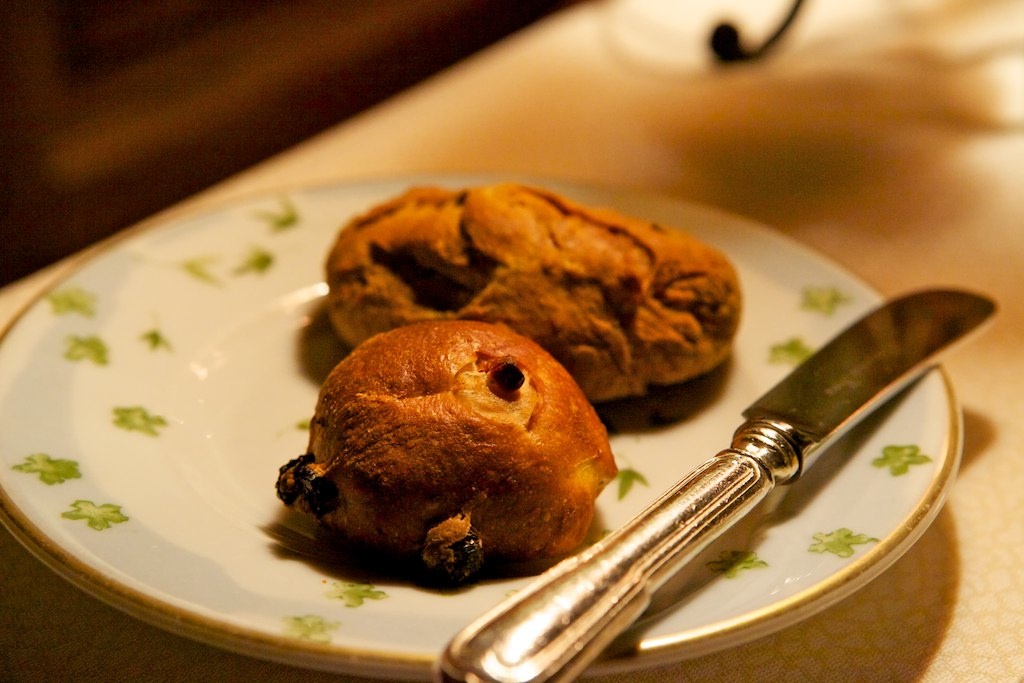
I’ve never been to Paris, but my impression is that the French have pretty much figured out how stuff should taste. Somebody in France figured out hundreds of years ago how to make the perfect croissant, and that’s still how you make a perfect croissant. (Not a good croissant? Starbuck’s. It’s a butter roll shaped like a crescent moon, but if I can eat it without covering my shirt in delicious crispy buttery crumbs, then you’ve wasted my time — and my $3.50.) My point here is that if you’re going to have a French(ish) restaurant, you can be tremendously creative about it and get away with an error here or there, or you can be mostly traditional. But again: traditional is fine, but it needs to be perfect.
Well, at least the company was perfect. We ate at Bouley with, um, “Fosco” and Ben, whom we’d never met in person, but had become friends with through the beauty of the Internets — first through Fosco’s blog, and then through Facebook. They were in NY for a few days so we all met for dinner. We started with cocktails, which were fun and fine, and then moved on to the appetizers. This is Ben’s appetizer, the “North Carolina Pink Shrimp and Cape Cod Sea Scallops, Sweet Maine Princess Crab, Point Judith Calamari (spelled wrong in the menu, by the way), and Ocean Herbal Broth.” I overheard Ben saying that the calamari was (not surprisingly) very chewy.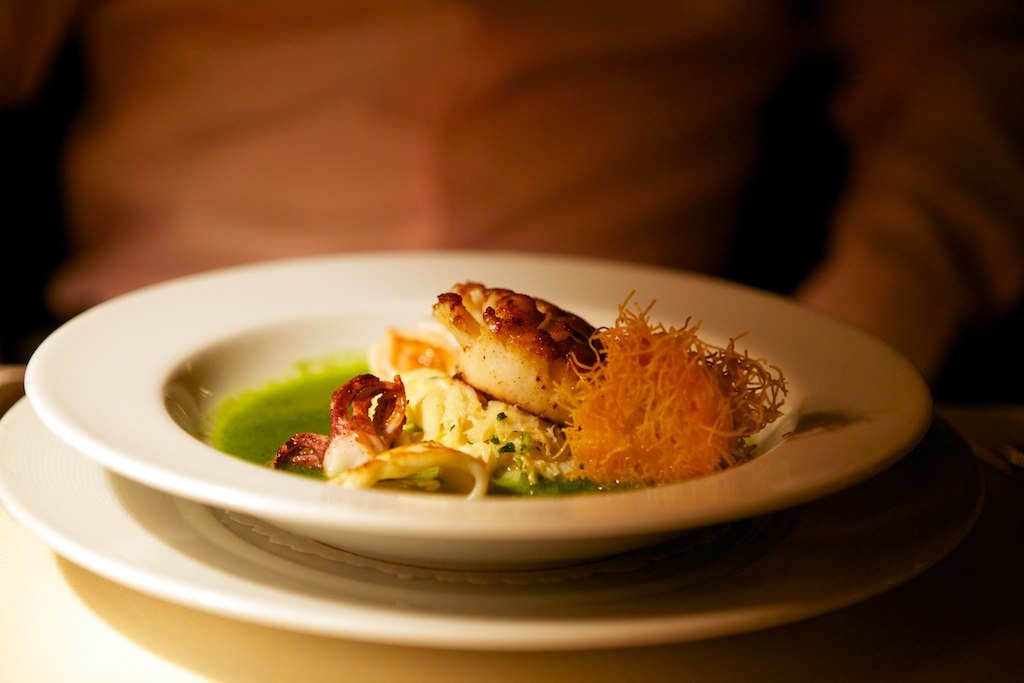
I had the “Harwich Wild Blue Fin Tuna, Chu Toro, Fresh Hawaiian Heart of Palm, and Yuzo-Miso Dressing.” (Didn’t I say recently that yuzu is everywhere now? And note to the menu typist: it’s “yuzu,” not “yuzo.”) This was perfectly nice tuna sashimi, but I didn’t get nearly enough yuzu flavor. (For a much tastier and more innovative take on sashimi at a non-Asian restaurant, check out Scarpetta.)
AEJ’s main course was the sous vide chicken. Again with the damn sous vided, non-seared meat. Is the entire clientele at these restaurants so old that nobody has teeth strong enough for meat anymore? The sauce was good, but the texture of the chicken was so “tender” that it lacked any texture at all. Also, the menu said this would be served with some sort of ravioli, but our waitress told us that in fact, the chef had decided today that the ravioli was terrible with the chicken, so there would be no pasta. What you see on the plate is all it was. (This dish has since been removed from the menu, by the way.)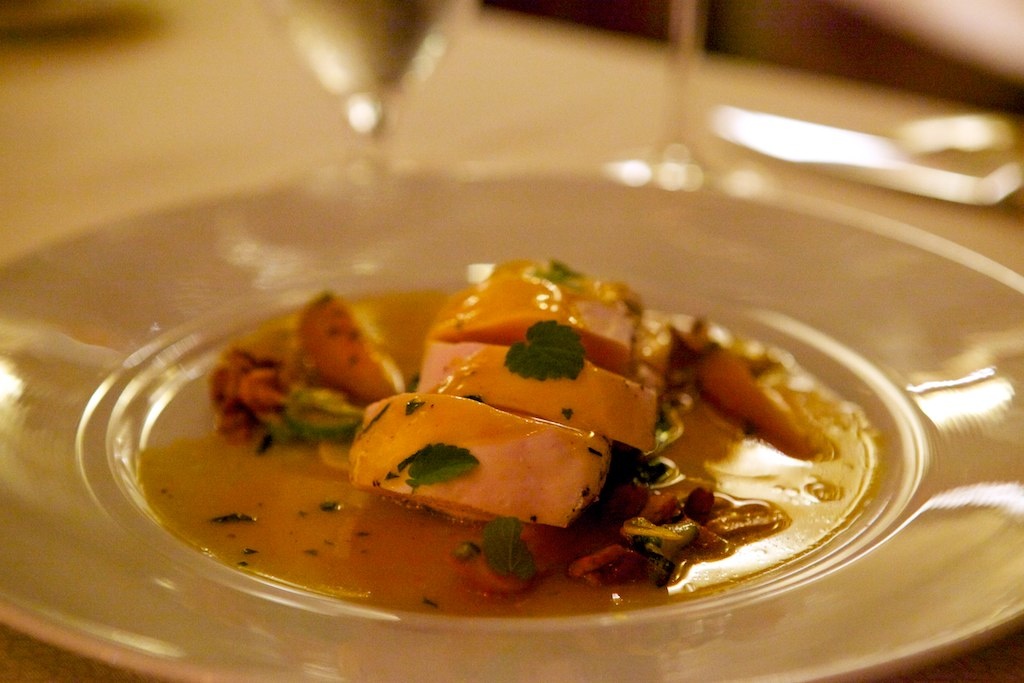
My main course was the “Maine Day Boat Lobster, Early Rhubarb, English Peas, Chervil Sauce, and a Parsnip Cloud.” The flavor was fine, but I prefer that my lobster be more buttery. The bigger problem? There were three generous pieces of lobster, and it wasn’t until my third piece that I noticed that this final piece was completely undercooked. Have you ever had undercooked lobster? It’s… slimy. Part of me wanted to say something to our waitress (the service was quite good, by the way), but it seemed silly after I’d eaten 2/3 of my dish. Still, there’s no excuse for undercooked lobster (or anything) at a restaurant.
For dessert, I had the “Hot Valrhona Chocolate Soufflé with Vermont Maple and Vanilla Ice Creams and Chocolate Sorbet.” This was very tasty, but why is my ice cream so melted? Before you ask, smart ass, it’s not because I’ve been taking pictures of it for 5 minutes. It arrived at the table this way. I mean, even without teeth, I could eat frozen ice cream. Serving it this way was ugly, and didn’t seem like it could possibly be correct. Two flavors of ice cream have completely melted together! France would be ashamed, Chef Bouley.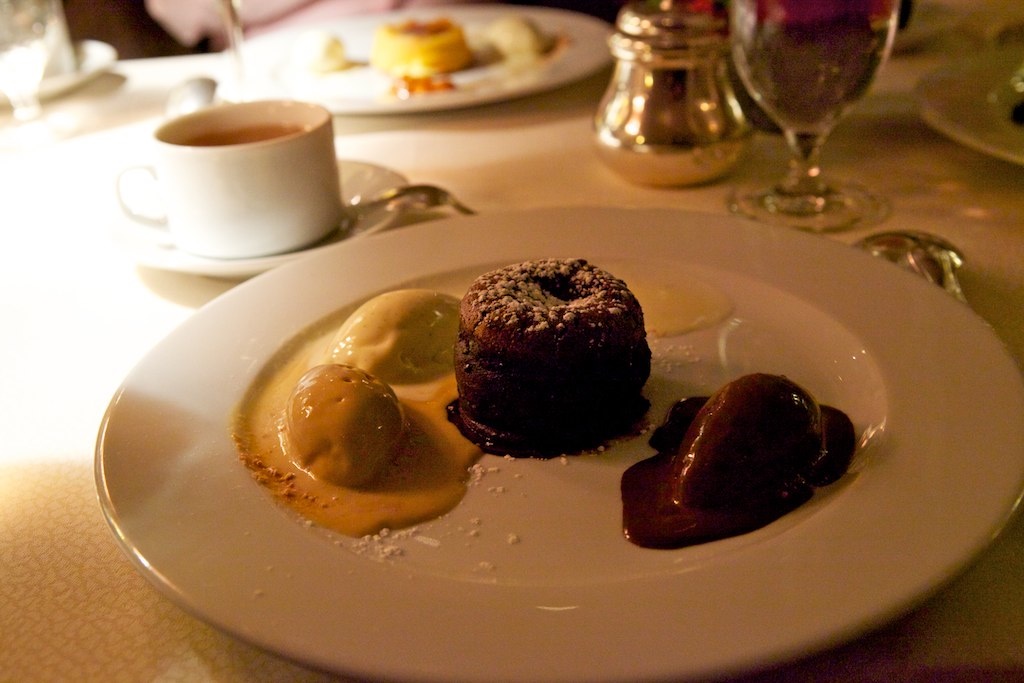
AEJ had the caramelized pear dessert. She said it was tasty, but again — why have they allowed the ice cream to completely melt around the plate and mix with other things?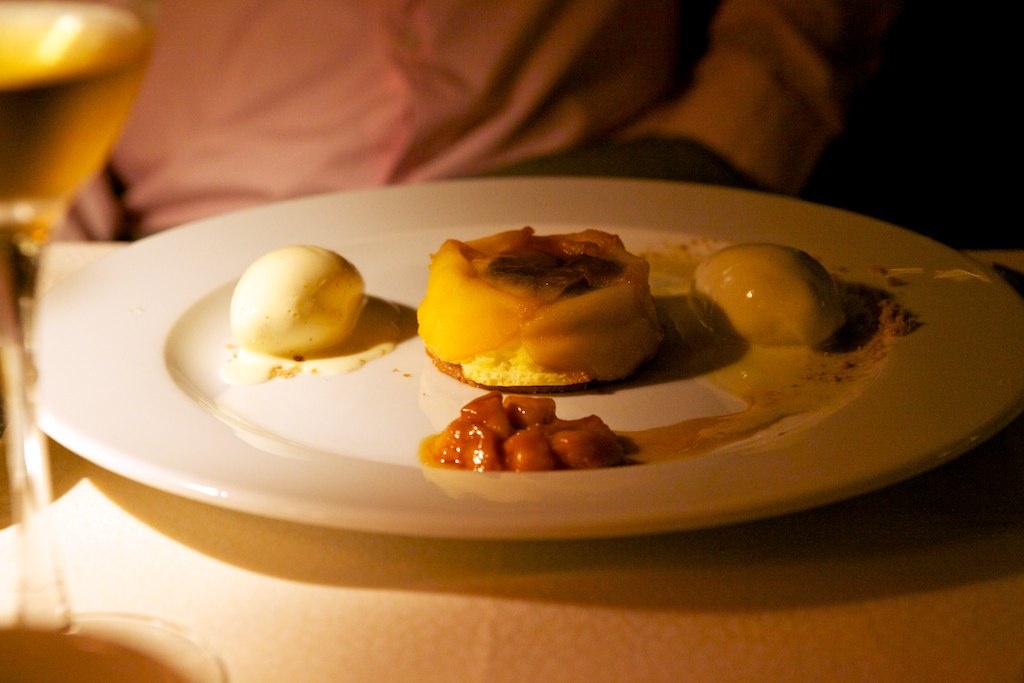
They also served this nice (and complimentary) sorbet (was it cream cheese flavor? I forget; there have been a lot of desserts this month…) on a strawberry rhubarb sauce.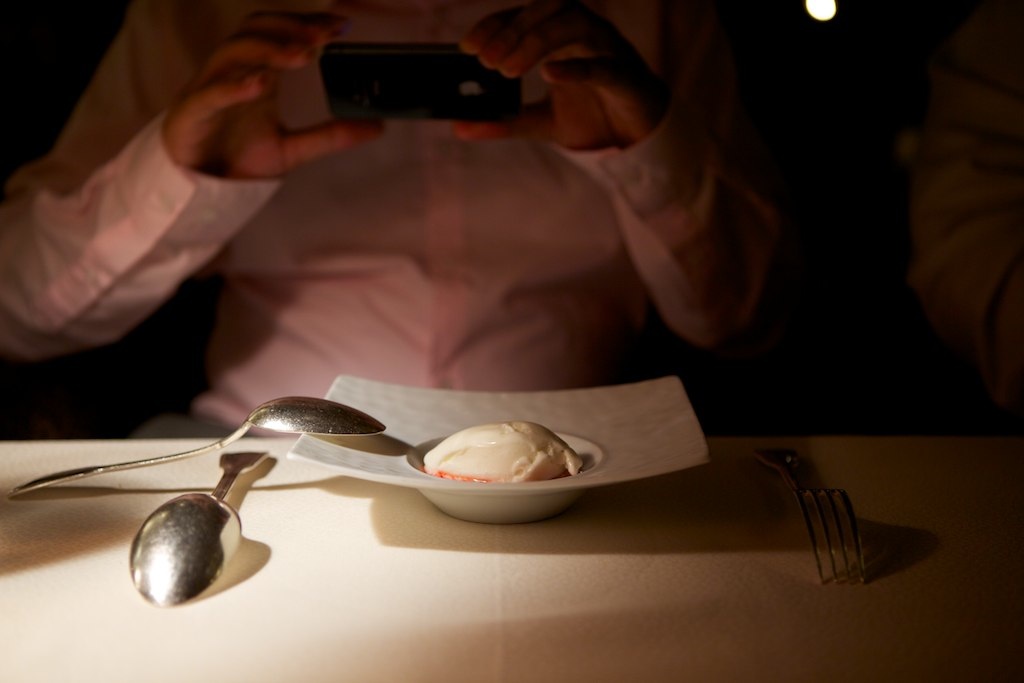
The dinner ended with a selection of “mignardises” — not unlike we’d had at Eleven Madison Park (which, for the record, is an infinitely more enjoyable dinner).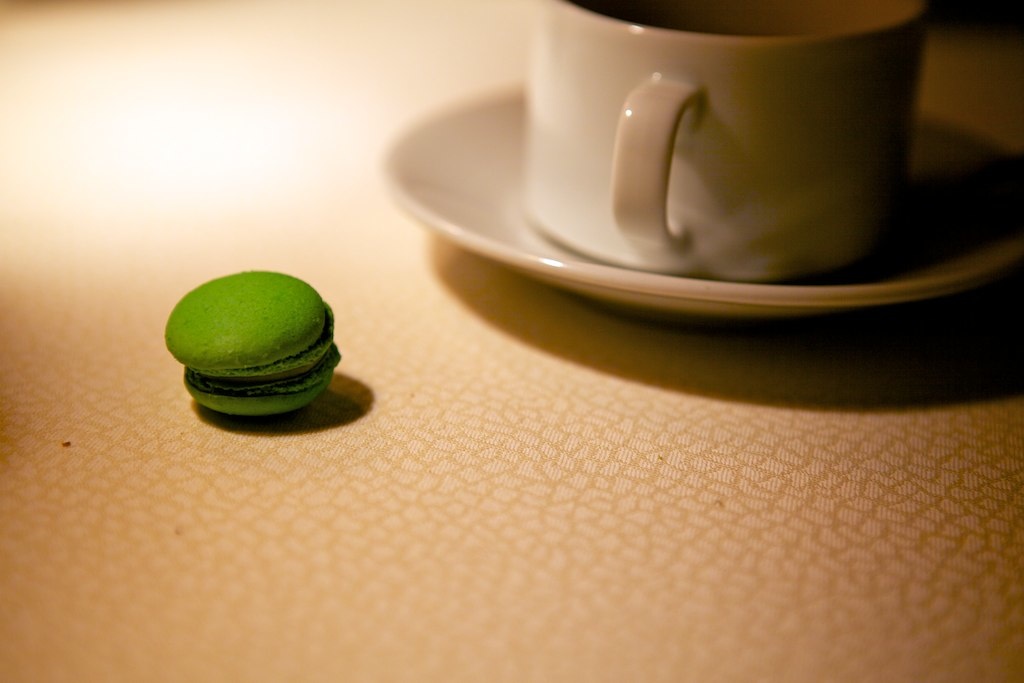
So the service at Bouley was very good, but the creativity was pretty low, and the quality of the preparation (undercooked lobster and overly-melted ice cream) wasn’t exactly top-notch.
We should have gone to Scarpetta again, where we could have had this incredibly simple — but perfect — spaghetti with tomato and basil sauce (If I do say so myself, I personally think this shot is prettier than the one on the Scarpetta website)…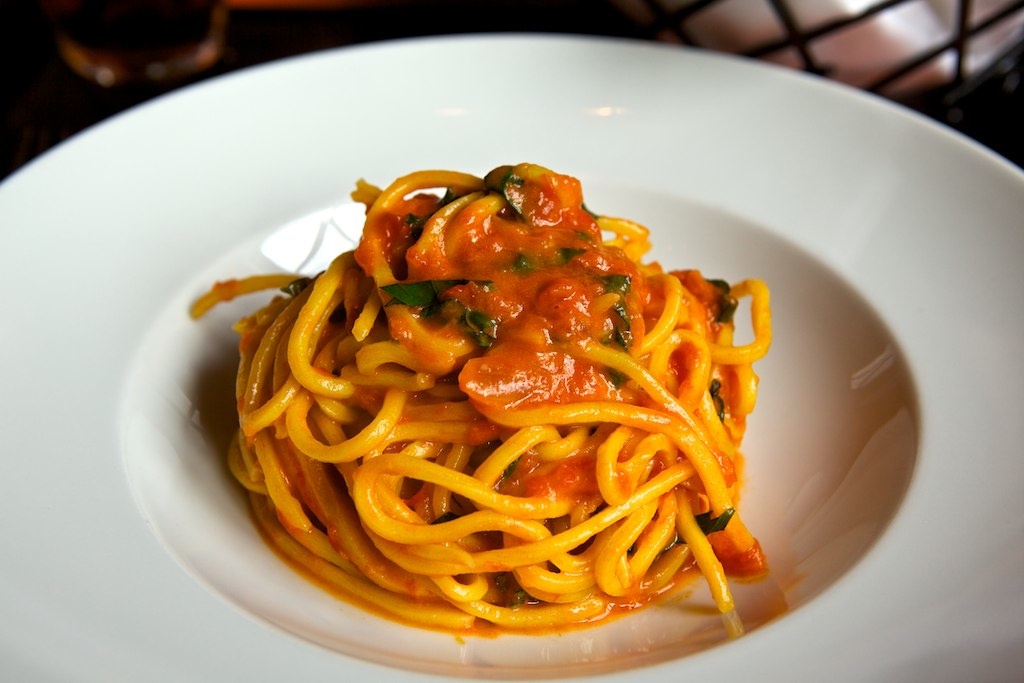
… and the ice cream isn’t melted when it arrives. (This is Scarpetta’s coconut panna cotta with guava soup and caramelized pineapple.)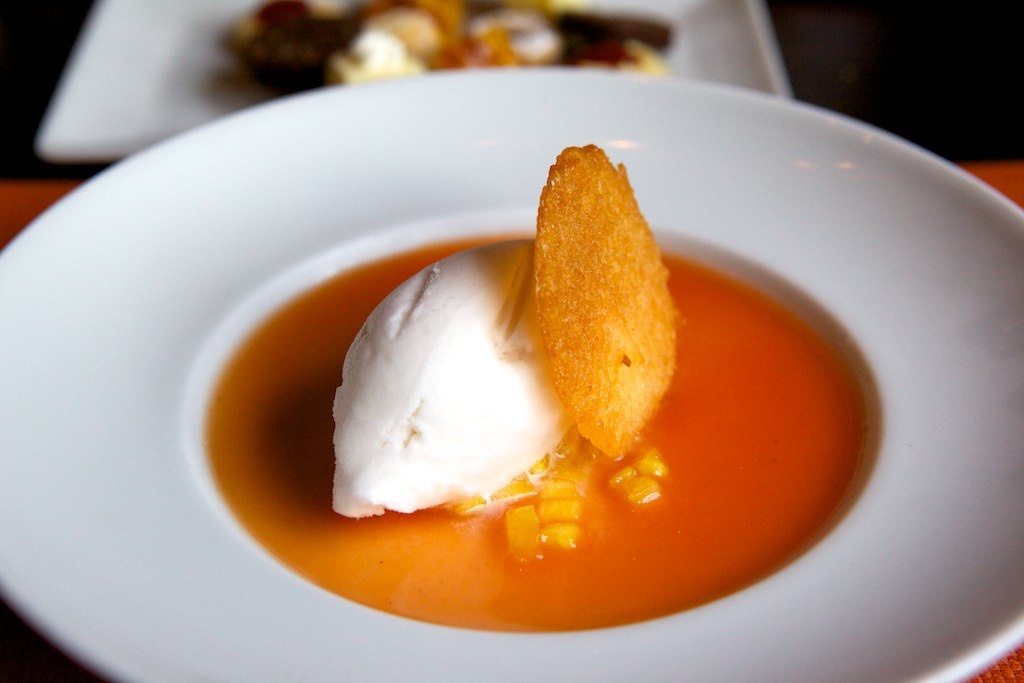
But Bouley? It feels like a place that people loved ten years ago, and they’ve kept coming because they haven’t noticed that the quality has dropped and other restaurants have surpassed it. My advice: go elsewhere.
View Comments
Comments
Scarpetta's spaghetti was featured on "The Best Thing I Ever Ate - Sauced" on Food Network. I agree your pic is even yummier looking than their stock pic.
~C
View Comments
Comments
T. Feng says
I love you so much for mentioning Bjork, you have no idea.
J. Thompson says
One of my trombone players said after overhearing "that opening should be a ring tone" I wholeheartedly agree...
Add comment